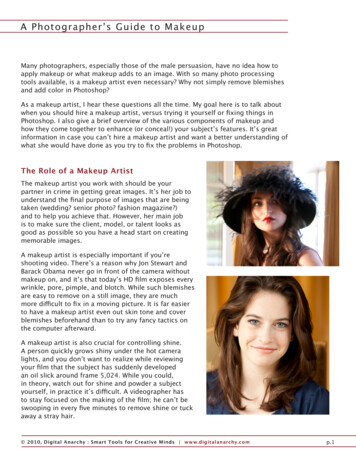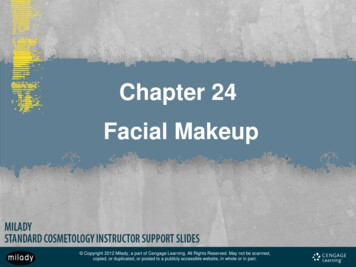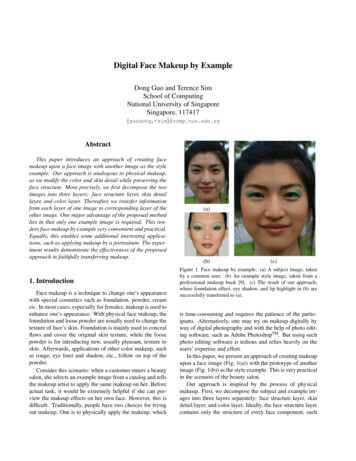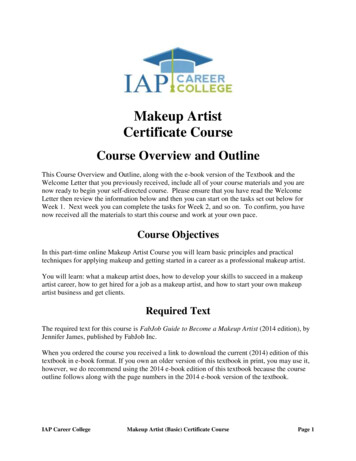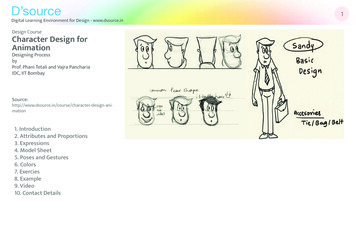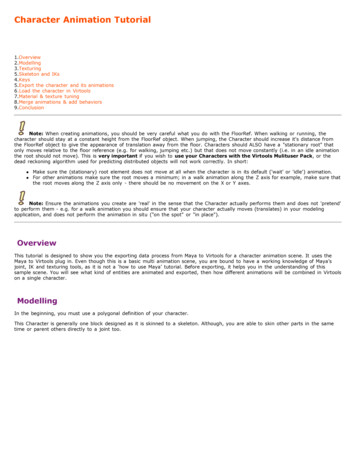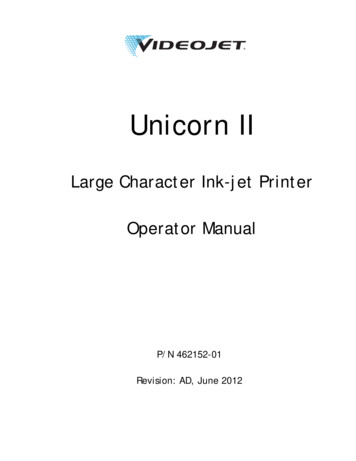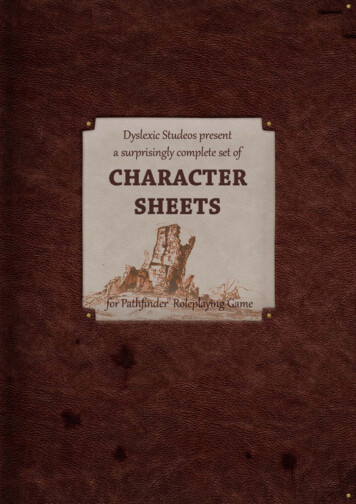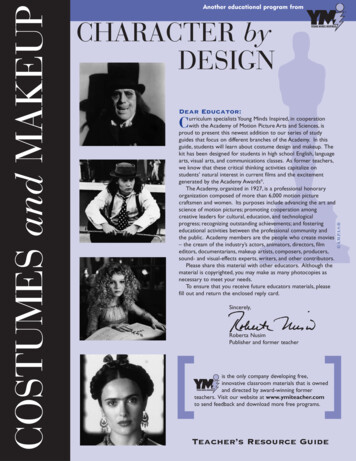
Transcription
CHARACTER byDESIGNDear Educator:Curriculum specialists Young Minds Inspired, in cooperationwith the Academy of Motion Picture Arts and Sciences, isproud to present this newest addition to our series of studyguides that focus on different branches of the Academy. In thisguide, students will learn about costume design and makeup. Thekit has been designed for students in high school English, languagearts, visual arts, and communications classes. As former teachers,we know that these critical thinking activities capitalize onstudents’ natural interest in current films and the excitementgenerated by the Academy Awards .The Academy, organized in 1927, is a professional honoraryorganization composed of more than 6,000 motion picturecraftsmen and women. Its purposes include advancing the art andscience of motion pictures; promoting cooperation amongcreative leaders for cultural, education, and technologicalprogress; recognizing outstanding achievements; and fosteringeducational activities between the professional community andthe public. Academy members are the people who create movies– the cream of the industry’s actors, animators, directors, filmeditors, documentarians, makeup artists, composers, producers,sound- and visual-effects experts, writers, and other contributors.Please share this material with other educators. Although thematerial is copyrighted, you may make as many photocopies asnecessary to meet your needs.To ensure that you receive future educators materials, pleasefill out and return the enclosed reply card. A.M.P.A.S. COSTUMES and MAKEUPAnother educational program fromSincerely,Roberta NusimPublisher and former teacher[]is the only company developing free,innovative classroom materials that is ownedand directed by award-winning formerteachers. Visit our website at www.ymiteacher.comto send feedback and download more free programs.Teacher’s Resource Guide
PROGRAM COMPONENTS1.2.3.4.This instructional guideFive student activity mastersA four-color wall poster for classroom displayA response card for teacher commentsTARGET AUDIENCEThis program has been designed for students insecondary school arts, science and communicationscourses.PROGRAM OBJECTIVES1. To enhance student interest in and knowledge aboutthe motion picture development and productionprocess2. To encourage students to use critical thinking as theylearn how narrative filmmakers work3. To engage students in an exploration of film as an artform and a medium of communication4. To help students become more media literateABOUT THE ACADEMYAND ITS AWARDSThe first Academy Awards were handed out on May16, 1929, not long after the advent of sound films. By1930, enthusiasm for the ceremonies was so great that aLos Angeles radio station did a live, one-hour broadcast,and the Awards have enjoyed broadcast coverage eversince. The number and types of awards have grown andchanged over the years to keep up with developmentswithin the motion picture industry. Awards of Merit—Oscars —are presented in each (or in subdivisions) ofthe following categories: acting, animation, art direction,cinematography, costume design, directing, documentaryfilms, film editing, foreign language film, makeup, music,best picture, short films, sound, visual effects, and writing.In an age when awards shows seem as common asnightly news programs, the Academy Awardspresentation is unique because the judges—theapproximately 6,000 voting Academy members—are topfilmmakers from around the world. The question “Whogets the Oscar?” is decided by a true jury of peers.While the Academy Awards provides a wonderfulopportunity to teach your students about the manycraft areas and the many communications techniquesthat play a part in creating a motion picture, it is onlyone of many programs and events sponsored by theAcademy of Motion Picture Arts and Sciences. Formore information, visit our Web site, www.oscars.org.Filmmaking is by nature a collaborative process, witheach creative area supporting the story and its depiction.Because our space is limited, this kit focuses on the artof makeup and costume design. Other kits can bedownloaded from www.oscars.org/teachersguide/.SELECTING FILMSFOR STUDENT VIEWINGStudents may select the films they wish to view for thefollowing activities, or you may wish to suggest filmsthat are appropriate. The following films have beennominated for the Academy Award for CostumeDesign, are available on DVD, and may be suitable foryour students ( indicates winners): All That Jazz(1979); The Addams Family (1991); Malcolm X (1992);Beloved (1998); Sleepy Hollow (1999); Crouching Tiger,Hidden Dragon (2000); 102 Dalmatians (2000); HarryPotter and the Sorcerer’s Stone (2001); Seabiscuit (2003); The Aviator (2004); Troy (2004); Ray (2004); Pride &Prejudice (2005); Walk the Line (2005); Dreamgirls (2006); Marie Antoinette (2006); The Devil Wears Prada (2006).The following films have been nominated for theAcademy Award for Makeup, are available on DVD, andmay be suitable for your students ( indicates winners): An American Werewolf in London (1981); Mask (1985); The Fly (1986); Harry and the Hendersons (1987); Beetlejuice (1988); Edward Scissorhands (1990); Star TrekVI The Undiscovered Country (1991); Mrs. Doubtfire(1993); Ghosts of Mississippi (1996); Men in Black (1997);Austin Powers: The Spy Who Shagged Me (1999); ABeautiful Mind (2001); Pirates of the Caribbean: The Curseof the Black Pearl (2003); The Chronicles of Narnia: TheLion, the Witch and the Wardrobe (2005); Cinderella Man(2005); Click (2006); Pan’s Labyrinth (2006).These features have been nominated for bothCostume Design and Makeup, are available on DVD andmay be appropriate for your students ( indicatesCostume Design winners; indicates Makeup winners): Gandhi (1982); Amadeus (1984); The Color Purple(1985); Coming to America (1988); The Adventures of BaronMunchausen (1989); Cyrano de Bergerac (1990); DickTracy (1990); Bram Stoker’s Dracula (1992); Braveheart(1995); Titanic (1997); Elizabeth (1998); Shakespeare inLove (1998); Topsy-Turvy (1999); Dr. Seuss’ How theGrinch Stole Christmas (2000); Moulin Rouge (2001); Frida (2002); The Lord of the Rings: The Return of the King (2003); Master and Commander: The Far Side of theWorld (2003); Lemony Snicket’s A Series of UnfortunateEvents (2004).INTRODUCTIONWhether a film is set in the present, the past, in adistant location, or in an imaginary time and place,costume designers and makeup artists collaborate withthe film’s director, cinematographer, and productiondesigner to tell the story. Actors bring the fictionalcharacters in the screenplay to life, and makeup artistsand costume designers assist that transformation.Costumes and makeup were first used in theatricalperformances. On a stage, the audience sees actors fromthe top of their head to the bottom of their feet.Theatrical costumes and makeup use bold colors andlarge design elements so they can be recognized from thelast row of the balcony. Costume designers and makeupartists in the theater work closely with their directors,set designers, and lighting designers to formulate aconsistent look for every play, ballet, or opera.Movies tell a story using cinematic language. Thislanguage includes camera angle, camera motion, framingof shots, editing, music, and special effects. Instead of
seeing each actor from head to toe, the audience seesonly what the director wants them to see and what thecamera allows. After filming is finished, the director willmake further artistic decisions in the editing roomabout which scenes to keep and which scenes to cut.Both costume designers and makeup artists workclosely with the film’s production designer, director,cinematographer, and actors, as well as with their owncrews and with each other, to create a total look thatconveys the film’s themes, setting, and moods.Activity One:COSTUMES –TELLING the STORYEvery garment worn in a movie is considered acostume. Costumes are a storytelling tool,communicating subtle details of each character’spersonality and history quickly and economically to theaudience. They help actors leave their own personalitiesbehind and become new and believable people onscreen.Although people often confuse costume design withfashion design, the two are very different. Fashiondesigners sell clothes; costume designers help characterscome alive. Costume designers can make beautifulgowns and extravagant clothes when the script requiresa glamorous entrance, but they also must designeveryday clothes when those are needed for a scene.Costumes are created to be worn by one specific actor,as one specific character, in one specific scene, accordingto costume designer Deborah Nadoolman.The costume design process begins with a carefulstudy of the screenplay. Scripts describe the action(what happens in the scene), time period (when theaction takes place), the location (where the action takesplace), and the number and identity of the characters ineach scene. After reading the script, the costumedesigner meets with the director to discuss the overallvision for the film and to consider the personalhistories of each character, possible casting choices, theoverall color palette, and the mood of the film.The costume designer then starts the researchportion of the design process. As part of that process,designers visit libraries, look at paintings, and studynewspapers, catalogs and magazines from the present orthe past, depending on when the movie is set.If a scene takes place in a modern high school, thecostume designer may visit a local high school and takepictures of staff, teachers, and individual students. Thedesigner would study the latest trends in jeans, handbags,and accessories and consider the socio-economicbackground of the school population, including howmuch the students spend on their clothes. Modern filmsare more difficult to costume than historical filmsbecause the audience is immediately aware if thecostumes are unrealistic for the situation, too expensiveor wrong. The designer’s goal is for members of theaudience to recognize themselves on screen.If that high school scene takes place in the 1950s, asin the period film Pleasantville (1998, with costumes byJudianna Makovsky), the designer might use vintage highschool yearbooks, personal photographs of friends andfamily, home movies, and magazines to research the film.If the school is in a fantasy film, such as Hogwarts inHarry Potter and the Sorcerer’s Stone (2001), the designermight research contemporary and traditional Englishprivate school uniforms and depend upon imaginationThe effect that costumes, makeup, and hairstyles can have in creating characters for motion pictures is illustrated best byexamining the varied “looks” individual actors have assumed throughout their careers. Kirsten Dunst is seen as she appearedas Judy Shepherd in JUMANJI (1995), as Amber Atkins in DROP DEAD GORGEOUS (1999), and as the title character inMARIE ANTOINETTE (2006). JUMANJI and MARIE ANTOINETTE Sony Entertainment, and DROP DEAD GORGEOUS New Line Cinema, All Rights Reserved.
for the rest. Although Harry Potter and his friends Ronand Hermione exist in an imaginary world, they muststill be characters that the audience can relate to.When a screenplay covers several decades, or is set ina distant location, costumes help the audience know whenand where each scene takes place. In the 2002 film Frida,based on the life of the Mexican artist Frida Kahlo (SalmaHayek), Frida evolves from a schoolgirl to a middle-agedwoman. Costume designer Julie Weiss dressed Hayek firstin a schoolgirl uniform, then as a young matron in thestylish dresses of the 1920s, then in colorful handembroidered Mexican Indian blouses similar to what thereal Kahlo wore for the rest of her life, as she becomes aconfident middle-aged artist and political activist. Kahlo’schanging costumes mirror her evolution as an individual.Designers often adapt vintage clothing, as AriannePhillips did in Walk the Line (2005), the story of countryperiod using history textbooks, costume history andfine art books, historic portrait paintings, newspapers,and descriptions in literary and historic work. Compareactual historic costumes to the costumes in the film.How accurate were the costumes in the film? Did itmatter if the costumes were not perfect reproductions?SUPPLEMENTAL ACTIVITYHave each of your students describe an article ofclothing or an accessory that he or she is wearing.Ask each to relate how he or she obtained theitem. Was it a gift or a purchase? Where did itcome from? How long has he or she had it? Doesit have sentimental value? Discuss with yourstudents how this kind of analysis and research isuseful for designing costumes.Wardrobe, makeup, and hair are essential ingredients that actors depend upon when creating characters for motionpictures. These portraits of Johnny Depp as Gilbert Grape in WHAT’S EATING GILBERT GRAPE (1993), as the titlecharacter in DONNIE BRASCO (1997), and as Sir James Barrie in FINDING NEVERLAND (2004) illustrate subtlechanges that immediately create different expectations for the audience. WHAT’S EATING GILBERT GRAPE Paramount Pictures, DONNIE BRASCO Sony Entertainment, and FINDING NEVERLAND Miramax Films, AllRights Reserved.music star Johnny Cash and his wife, June Carter.Phillips mixed the vintage garments she found with onesshe designed using vintage printed fabrics from the1950s and 1960s. She insisted on old fabric becausesynthetic contemporary fabrics do not move or drapein the same way.Costumes do not have to exactly duplicate the film’speriod, but they need to look right to the audience.Designers may exaggerate color, style, and silhouette fordramatic effect. For example, when the director ofMemoirs of a Geisha felt that a sexier, morecontemporary look would be more appealing to nonJapanese viewers, designer Colleen Atwood fashionedkimonos that were more shape-revealing thantraditional garments.Show your students a period film (one set in thedistant or recent past). Discuss how the costumesreveal when and where the film takes place. Do theperiod costumes affect the actor’s voice and movement?Ask students to research actual clothing from thatActivity Two:ICOSTUMES –CREATINGCHARACTERSn real life, people don’t always wear an outfit in whicheverything is brand new. A teenage girl might wear afavorite well-worn skirt, a pair of earrings from the localmall, and a birthday scarf from her best friend. Althoughthe audience meets film characters when the moviestarts, like real people the characters must seem tohave lived before the story begins.Before shooting starts, hidden motivations in acharacter’s personality—anxiety, depression, moneytroubles, a drinking problem—and the character arc (theemotional and psychological transition the charactermakes through the film) are analyzed by the director,costume designer, makeup artist, and actor to determinethe most effective way to tell the story. Costumes
convey information about the characters’ social andeconomic circumstances, their personalities, and theirrole in the story before one word of dialogue is spoken.In In Her Shoes (2005), Maggie, played by CameronDiaz, is a free-spirited young woman and dresses insexy, colorful prints, while her down-to-earth and welleducated sister Rose (Toni Colette), wears business-like,solid-colored suits. Designer Sophie de Rakoffaccentuates Maggie and Rose’s contrasting personalitieswith subtle and specific choices of accessories.Costume designer Sharen Davis’s costumes for the1950s girl group in the musical Dreamgirls (2006) reflectthe course of the girls’ career from amateur talentcontests to worldwide fame. When they first start out,these young singers wear simple, homemade dresses.With greater success, their costumes become moresophisticated and glamorous.Costumes may be purchased new, rented, ormanufactured. When necessary, costume designers usea variety of techniques to make them look realisticallylived in. Garments are darkened, faded, or frayed inplaces where this process would happen naturally overtime. After a few wearings, all jackets, jeans, and shirtsshow wear on the cuff, collar, and hem. Jeans bag at theknee and pockets are stretched by car keys and cellphones. A mechanic’s uniform might have grease stainswhere he habitually wipes his hands.To age or “break down” a costume, the designer andcostume crew begin by washing or dry cleaning new ornewly made garments multiple times. Aging toolsinclude suede brushes to scrub leather, dye to colorclothes, and mineral oil to add “sweat stains” to hats.The crew uses a combination of bleach, airbrushes,sandpaper, razor blades, files, seam rippers, and hammersto fray and discolor the costumes. A sterile clayproduct called fuller’s earth is often used in Westerns tomake cowboys look like they have been sleeping out onthe dusty trail.If costumes are purchased or rented, they must bealtered to fit each actor. After actor Harrison Fordtried on many different hats for his role as Indiana Jonesin Raiders of the Lost Ark (1981), costume designerDeborah Nadoolman devised a hat with a lower crownto flatter his face, and a narrower brim to keep Ford’sexpressive eyes exposed to the camera.Although Nadoolman might have purchased a vintageleather jacket for the character, because the script calledfor action sequences using stunt doubles, she insteaddesigned and manufactured a dozen new leather jackets.Each jacket was then aged to look identical on screen.Costume designers also provide costumes forsupporting actors, stunt doubles, extras (also calledbackground talent), and even animated characters. Eachof these has special considerations. For example, stuntperformers wear exactly the same costumes as theactors they are doubling in an action scene, but theircostumes must be constructed to accommodate safetyfeatures such as padding and rigging for gunshots(squibs), high falls, or stunt driving.Costumes for background talent are designed in theappropriate period and style. Bugsy (1991) costumedesigner Albert Wolsky says,“I care a great deal aboutextras, because they’re like scenery. They set the tone.You can’t just create the period with your principals; ithas to be the extras.” Background talent and supportingactors’ costumes should have the right colors and stylefor the film’s setting, but be understated enough that theydo not draw attention away from the stars.Read a character description from a screenplay orbook. Have your students list everything they knowabout the character, including age, social status, attitudes,background, and gender. Discuss the character’s arc andlist the challenges or turning points he or she faces. Askthem what the costumes should say about the characterat each important point. Have them consider whatcolors, patterns, accessories, and clothing accents, suchas buttons, lace, ribbons, and neckties, would beappropriate for the character and why. Have thestudents create a costume design for the characterusing drawings, collages, pictures from magazines, orclothing to show what the character would wear, andhave them explain their choices to the class.SUPPLEMENTAL ACTIVITYWe all choose different outfits for differentoccasions. Divide your students into small groups.Give each group a specific situation, such as a jobinterview, a date, or hanging out at home. Askthem to create an appropriate costume usingitems from their own closets. Have each grouppresent the costume in class and ask the otherstudents to guess for what occasion the student isdressed. Then have them discuss the reasoningbehind the choices they made. Discuss how thecostume would change if the character were olderor younger, from a different ethnic or socioeconomic group, or from a different part of thecountry. How does each part of their costumecontribute to the final effect?Activity Three:COSTUMES –PAINTING the FRAMECostumes are part of the visual composition of eachframe of film. Just as the elements of a paintingwork together to create a harmonious image, costumesmust work with the lighting and sets. Color, shape, line,and texture are all considered when designing costumesfor a movie. Color, one of the most importantelements in the designer’s tool kit, suggests the moodand atmosphere of a story. Warm reds produce adifferent effect from subdued blues, for example.A dismal, oppressive future world, such as the onedepicted in the film Blade Runner (1982), with costumesdesigned by Charles Knode and Michael Kaplan, usedcool, dark shades to evoke a bleak mood. Costumedesigner Nancy Steiner used different colors to subtlyindicate the personality of each member of thedysfunctional family in Little Miss Sunshine (2006). While
the costumes’ colors may go unnoticed by theaudience, they subconsciously affect viewers’perceptions of the characters.Costumes are also used to focus attention on themajor actors and the important action in a scene.Jeffrey Kurland, costume designer for Erin Brockovich(2000), dressed the secondary characters in colors thatwould not detract attention from star Julia Roberts.The sandy earth tones of their costumes echoed thefilm’s desert setting and provided a neutral backgroundagainst which Roberts’s bright and provocative outfitsstood out.Costumes can change the shape of an actor’s bodyto reflect the period and the personality of thecharacter. Revealing, close-fitting clothes look sexy,while clothes that hide the body could make acharacter seem conservative or shy. Soft silhouetteslend characters a vulnerable or compliant quality, whilestiff, tailored clothing conveys authority. Iconiccharacters like Charlie Chaplin’s Little Tramp can berecognized just by their silhouettes.Pads may supply a very slim actress with a few extrapounds or a pregnancy, or give a well-built actor theappearance of narrow, stooped shoulders. Pads, girdles,and other garments can even make an actor appear tobe a different gender, the way they transform GwynethPaltrow at one point in Shakespeare in Love (1998), orRobin Williams in Mrs. Doubtfire (1993).Designers often work from the inside out whencreating a character. Period underwear from the 19thcentury or the early 1950s may never be seen by theaudience, but the way it affects actors’ movements alsoaffects both their silhouettes and their performances.An actress wearing a corset or a girdle, for example,stands more erectly and moves with much moredifficulty than if she were wearing lightweight modernunderwear. Each historical setting demands differentgarment shapes—from the soft drapery of Romantogas, to the rigid hoopskirts and bustles of theVictorian era, to the miniskirts of the 1960s.Shoes also affect the posture and gait of an actor.The bowlegged stroll of a cowboy in boots, the bounceof a high school student in sneakers, and the strut of afashion model in high heels speak volumes about eachperson. Often, costumes help actors discover theircharacter. In the 2006 film Pirates of the Caribbean: DeadMan’s Chest, costume designer Penny Rose presentedactor Stellan Skarsgärd with a pair of shoes that wereone size too large. Rather than discard the shoes,Skarsgärd invented a distinctive walk for his character,sailor “Bootstrap Bill.”Texture is the way fabric feels to the touch andlooks to the eye. Fabric textures range from theroughness of burlap to the smoothness of silk. Agarment’s texture may hint at a character’s profession,social status and economic situation. A farmhand mightdress in rough coveralls, while an arctic explorer mightwear reflective nylon clothing filled with down.Because the camera and lighting affect the waycolors and textures look on film, costume designerswork closely with cinematographers. Certain fabricsare distractingly shiny in front of the camera. Patternsand textures that look great in person may be ugly oroverwhelming when magnified on a movie screen fortyfeet wide. When there are doubts about a certainfabric or the look of a character, the director may askfor camera tests to make sure the costume has thedesired effect.Show your students a scene from one of the movieslisted above or from a movie of your choice. Ask themto describe the main character(s) in the scene. Explainwhat happened in the scene. Have them analyze thecolor palette of the scene, the different textures used,the silhouette of the costumes. Ask them what each ofthese elements revealed about the character(s).Discuss the ways the costumes distinguished the maincharacter(s) from the background and secondarycharacters in the scene.SUPPLEMENTAL ACTIVITYUsing the library and the Internet, have yourstudents research how the look of costumes in aspecific genre, such as Westerns or science fiction,has changed over time. Discuss the reasons forthe difference with your students.Activity Four:LMAKEUP –BEGINNINGSike costume designers, makeup artists arestorytellers. Whether the script requires actorsto look beautiful or ragged, younger or older, or likemonsters or other fantastic beings, makeup artists andhairstylists help audiences believe that what they see onthe movie screen is real.Movie makeup is a combination of art and science.It is both corrective, covering flaws and emphasizingattractive features, and creative, enabling actors toinhabit almost any type of character. Movie makeupthat is used to hide pores, wrinkles, and other facialimperfections must withstand close scrutiny whenmagnified on screen. Makeup and hairstyles must looknatural, but be durable enough to last for long hoursunder hot lights while actors fight, kiss, and sweat.Good makeup design requires research,experimentation, and sometimes inventing makeupproducts or appliances.In 1914 Max Factor, a makeup artist and chemist,created the first makeup specifically for movies: light,semi-liquid greasepaint. Early black-and-white film stockdid not register a range of colors. Red tones, forexample, looked black on screen, so actors compensatedby using makeup with blue or green tints. After thedevelopment of panchromatic film, which recorded theentire color spectrum, more natural-appearing makeup,called panchromatic makeup, was developed.Most silent film actors created and applied their ownmakeup. One of the most inventive was Lon Chaney,who is often called the “man of a thousand faces.” He
Lon Chaney Sr. is widely acknowledged as the most important early innovator of motion picture makeup effects; hetransformed himself into many iconic characters that still resonate decades later. Top row (left to right): Chaney in thedisguise used by Inspector Burke in LONDON AFTER MIDNIGHT (1927), the costume worn by the Phantom in themasquerade scene from PHANTOM OF THE OPERA (1925), the Phantom as he appears after being unmasked in THEPHANTOM OF THE OPERA (1925). Bottom row (left to right): Chaney in a studio publicity portrait illustrating his reallife appearance, as Quasimodo in THE HUNCHBACK OF NOTRE DAME (1923), and from an unidentified film. Photosfrom the collection of the Margaret Herrick Library of the Academy of Motion Picture Arts and Sciences.used materials such as fish skin, mortician’s wax, andwigs to shape his characters. In the 1926 film TheRoad to Mandalay, he wore a glass eyepiece similar to amodern contact lens to make one eye look blind. Forhis role as Quasimodo in The Hunchback of NotreDame (1923), Chaney devised a 20-pound plasterhump held on by a leather harness that temporarilydeformed his posture.In 1931, makeup artist Jack Pierce created thememorable monster in Frankenstein. Pierce researchedsurgical techniques and human anatomy to imaginewhere the monster’s skull bones might have beenjoined if a scientist could actually construct a man. Hesoaked layers of cheesecloth in a thick liquid calledcollodion and used this to painstakingly build up actorBoris Karloff’s face. A heavy layer of greasepaintcovered the entire construction.Later materials such as latex rubber resulted inlighter and more flexible appliances and prostheticssuch as fake noses and ears. Unlike the wax used byLon Chaney, latex didn’t crack and could be applied inthin coats for a more lifelike appearance. The 1939film The Wizard of Oz was the first major film to usefoam latex prosthetics on a large scale. Makeup artistsJack Dawn, Charles Schram, and others attachedpreviously prepared pieces to the actors’ faces everymorning, which saved time in the makeup chair andensured consistent results throughout filming.Contemporary prosthetics may be as subtle as thenose worn by actress Nicole Kidman in the film TheHours (2002), or involve a more complicatedtransformation. James McAvoy, who plays Mr.Tumnus,a half-goat, half-human faun in The Chronicles of Narnia:The Lion, the Witch and the Wardrobe (2005), was fittedwith a fiberglass skullcap, silicone ears, and a radiocontrolled device to make his ears wiggle.
In recent years, digital technology has been used onits own or in combination with traditional makeuptechniques to create effects that would not have beenpossible in the past. The hairy parts of Mr.Tumnus’supper body and face were laid down by hand usingtraditional makeup techniques, but to create the faun’sgoatlike legs, McAvoy’s own legs were digitally removedfrom all frames, and the faun’s legs digitally inserted.New software programs can be used in postproduction to remove wrinkles and blemishes, enhancemuscle definition, and whiten teeth.High definition (HD) digital technology’s greatersharpness and clarity poses further challenges to makeupartists and hairstylists. Because current film makeuplooks too heavy in high definition, makeup artists aredeveloping more translucent and reflective products.High definition also changes the way hairstylists approachtheir task. Rather than trying to keep styles looking thesame from frame to frame, hairstylists working in HDmust develop more relaxed, natural-looking hairstylesand less reflective hair products.Ask your students to design a makeup. This could beas simple as cutting p
costume designers and makeup artists collaborate with the film’s director,cinematographer,and production designer to tell the story. Actors bring the fictional characters in the screenplay to life,and makeup artists and costume designers assist that transformation. Costum

